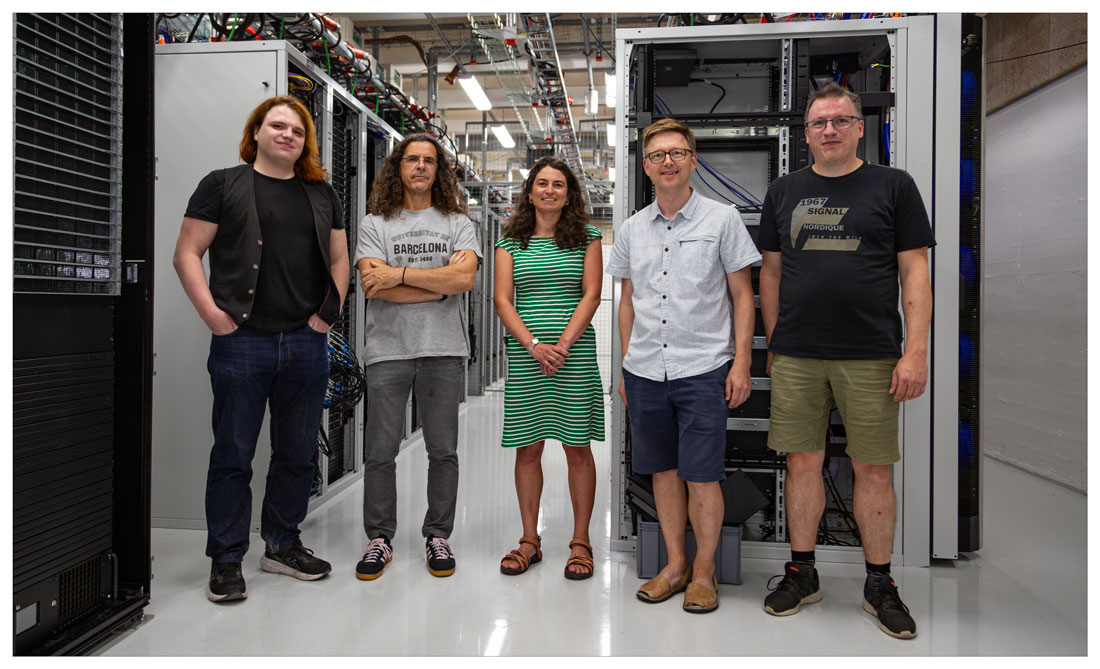Tycho supercomputer gets new green superpowers
With a new expansion of the Tycho supercomputer, the University of Copenhagen will get its first water-cooled and green supercomputer.

The computer will be a virtual laboratory that supports research into biological soft matter such as bacterial colonies and cell tissue, gravitational waves, the foundations of gravity and observations and models of how the first galaxies formed in the early Universe.
Tycho, which cost 4.1 million kroner, has been acquired by four research groups at the Niels Bohr Institute led by Charlotte Mason, Kristian Thijssen, Maarten van de Meent and Vitor Cardoso. It will be installed in the SCIENCE HPC center at the H. C. Ørsted Institute in Copenhagen, where the rest of Tycho is already located.
Green computing
The hardware in the Tycho supercomputer is exclusively externally funded by a collaboration between physicists at the University of Copenhagen, while SCIENCE supports the operation and hosting of the machine.
More than 200 researchers and students rely on Tycho daily to carry out their research. It is tailored to support computer-driven scientific discovery, including large-scale modeling, predictions for specific experiments and observations, and data-intensive analysis.
Supercomputing is a central tool in science today and has emerged as a third pillar of the scientific method. It requires large amounts of electricity, but can save similarly large amounts by using models instead of experiments and enabling discoveries in areas where experiments are not possible, such as in the study of black holes.
The Foundations of Gravity
Vitor Cardoso, a professor at the Niels Bohr Institute specializing in Black Holes and Gravitational Waves, explains that with this computational power, exciting new knowledge awaits us. One example concerns understanding the role of gravity in collisions of powerful light beams.
What happens where light collides with light? What is the ultimate luminosity that ends up forming black holes? Do we see quantum effects, such as pair production of particles and antiparticles in this process?
The first galaxies and the early universe
The expanded Tycho supercomputer will allow Charlotte Mason’s team to process new James Webb Space Telescope data from thousands of galaxies which existed just a few hundred million years after the Big Bang, and use them to test theories in a virtual laboratory of the universe.
“We can now create millions of mock universes and compare them against JWST (James Webb Space Telescope) data.”
She explains, “This will help us answer key questions like: How did light emitted by the first galaxies impact the universe around them? What role did dark matter play in the formation of the first galaxies and black holes?”
Emergent collective phenomena in biological systems
Microorganisms are everywhere constantly interacting with, and reshaping their environment. Their exchanges with a large-scale surrounding medium form dynamic feedback loops: the environment influences and constrains microbial behaviour, while microbes, in turn, modify their surroundings to their advantage.
These mutual interactions drive processes that range from fertilization and gut health to infections and industrial biofouling (unwanted accumulation of microorganisms on surfaces in industrial systems).
By leveraging advanced computing technologies, Kristian Thijssen is developing new models to uncover how small-scale microbial dynamics (the study of the interactions of microorganisms (bacteria, fungi, etc.) and their impact on the environment, as well as how the environment affects them) lead to large-scale effects, leveraging the new advanced computing power to unveil these hidden dynamics.
Taking the environment into account
However, as researchers, we must be environmentally responsible in our use of computing resources and choose solutions that minimize the environmental impact of computers.
"Thanks to the far-sighted planning of Hans Henrik Happe and the SCIENCE HPC center when they designed their new data center, it is possible to install a liquid-cooled supercomputer at the University of Copenhagen.
The hardware costs for the research groups are higher than with a traditional air-cooled solution, but we decided that it was the responsible choice for us as researchers to support the green agenda of the University of Copenhagen.

Tycho together with four of the main users - from left: Kristian Thijssen, Vitor Cardoso, Charlotte Mason, Troels Haugbølle. To the right: Hans Henrik Happe, the head of the SCIENCE HPC center. Photo: Ola Jakup Joensen, NBI.
In addition, SCIENCE will achieve much greater savings on electricity over the lifetime of the machine, and it is our small contribution to balancing the budget in the midst of the faculty's financial turmoil. Furthermore, the servers can be placed closer together in the data center because water cooling is so much more efficient, saving expensive floor space in the data center," explains Troels Haugbølle, who coordinates the researchers using Tycho.
Contact
If you want to know more about Tycho, you can contact:
Troels Haugbølle, Associate professor
E-mail: haugboel@nbi.ku.dk
Phone: +45 29 38 25 88
